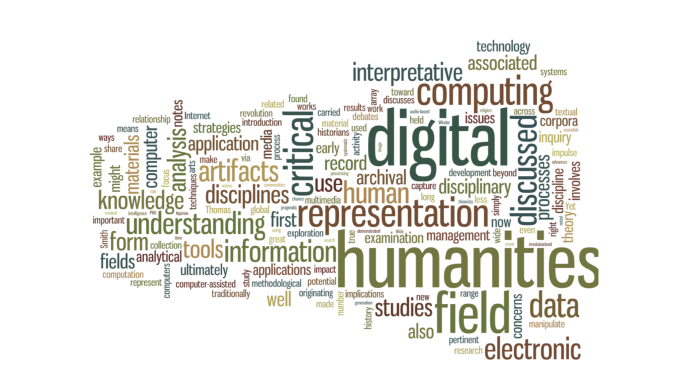
This is actually a controversial question. But to begin with I’m going to state the position of the Digital Arts and Humanities Lab on this, which has emerged in response to the interests of our academic staff and research students. Our definition is broad, reflecting the diversity of our Arts Faculty.
First we start with a definition of the humanities:
those branches of knowledge that concern themselves with human beings and their culture or with analytic and critical methods of inquiry derived from an appreciation of human values and of the unique ability of the human spirit to express itself.
Britannica, T. Editors of Encyclopaedia (2021, April 22). humanities. Encyclopedia Britannica. https://www.britannica.com/topic/humanities
That covers much of what we do in the Faculty. But it is missing two key dimensions important to our unique formulation of these practices:
- we use creative methods too, both as an experimental means to explore humanity and culture (especially strong in Theatre Studies), and as a way to transform the world for the better;
- for us the community of researchers engaged in this includes students and the wider public.
Analytic, critical, and creative. Through the collaborative work of researchers, students, and members of the public. Digital tools are enhancing and extending our powers to achieve these goals in many ways already. Our definition of the scope of Digital Humanities includes all aspects of this. We could argue that we should use a broader term: Digital Arts and Humanities, to reflect better the creative aspect. But for now, with the term Digital Humanities widely established globally, we will stick with that.
Alternatively, we might argue that we should stop using the term altogether (now or in the near future). As digital tools become ubiquitous in life and work, the separation of “humanities” from “digital humanities” makes no sense. There are just different variations of humanities practice using various tools (many of which are digital). Well-designed technologies certainly should just disappear into the background, doing their jobs without seeming like anything different, special, or problematic – this is called “calm technology“). However, there always seem to be new things coming along and demanding our attention, so perhaps the time when we can stop thinking about Digital Humanities is some way off?
I’ve been involved in this Digital Humanities business for a long time (in fact since 1993, when as an undergraduate I built one of Warwick’s first academic web sites). I’ve seen hype-cycles around tech come and go. An innovation arrives to great excitement, offering (or threatening) to change everything. Some people adopt it in some ways. And then things calm down. Older academics have seen it all, and when faced with news stories about the impending impacts of new tech (currently AI), just tut and roll their eyes. But over the years we have got better at understanding the potential (good and bad) of new tech, and adopting it carefully and appropriately into practice. Digital Humanities also concerns effective practices for adopting and adapting tech.
There is a technical aspect to this, as well as an ethical dimension:
- technical – concerning the effectiveness of our tools and techniques;
- critical – concerning the nature of knowledge, its production, and relationship with power – for example, how AI reproduces biases.
This is sometimes talked of as being a new branch of Digital Humanities, or a new field of study in itself: critical digital studies. I argue that, as technology becomes more ubiquitous, hidden, and calm, we need to do more actively to critically evaluate its impacts (bad and good). And that is an essential task for the humanities.
So for us in the DAHL, Digital Humanities concerns:
the effective, ethical, thoughtful
adoption, adaptation and application of
digital tools and techniques to
describe, analyse, critically evaluate, and creatively apply knowledge about humans and their cultures.
But why the controversy?
Technology, and the study of technology, has for many years had a precarious position in the humanities. Resources are limited. Existing patterns of institutional organisation can seem to be incompatible with the new forms of collaboration that are required. Consequently the people responsible for making big advances can be protective of the identify of the field. This is explained well by David Golumbia in his blog article “‘Digital Humanities’: Two Definitions” – the two definitions being our broader scope as described above, and a narrower version concerning archives and new tools for using them (see for example “What are the digital humanities?” by David M. Berry).
At Warwick we have been relatively isolated from this debate. But it is important to be aware of it, especially as you develop your career and look for opportunities elsewhere. As for the DAHL, we are taking a pragmatic approach, to fit with our own institution and its goals.

Leave a Reply